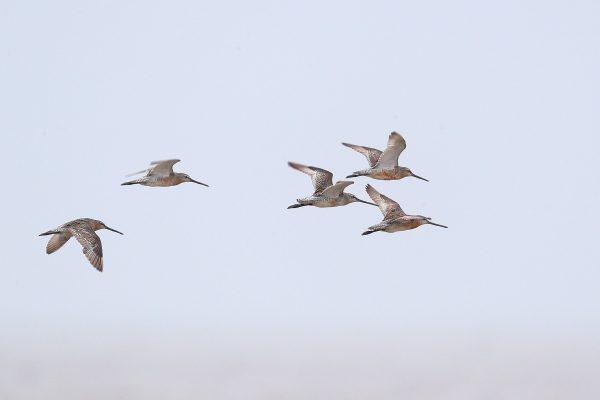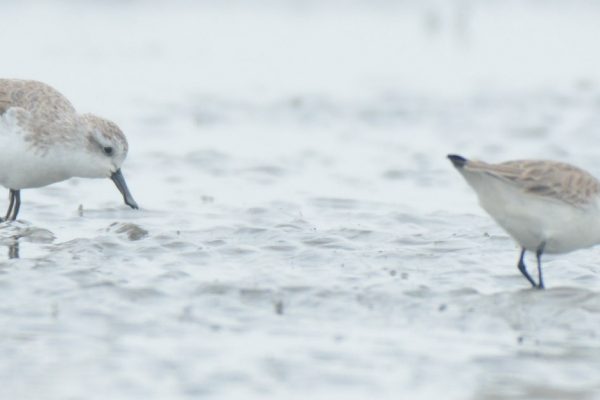-
“Flyway: connecting people and migratory waterbirds” story series #11 – Ms. Jing Li, Co-Founder of Spoon-billed Sandpiper in China
If you are aware of conservation work for Spoon-billed Sandpiper, you may have heard about Spoon-billed Sandpiper in China (SBSinChina), a local NGO aiming to protect this Critically Endangered…
Continue reading -
Lianyungang, an important yet overlooked stopover site in the southern Yellow Sea
A Dalmatian Pelican is making Lianyungang pancakes for an Asian Dowitcher, a Eurasian Oystercatcher and an Ancient Murrelet. All four birds rely on Lianyungang during their annual migration. Illustrator © Nemo. Over the past few decades, people have come to realise that tidal flats along the Yellow Sea-Bohai Bay are of paramount importance to migratory shorebirds along the East-Asian Australasian Flyway (hereafter EAAF). For example, several sites along the southern Jiangsu province of China have been recognised as the critical staging ground for globally endangered shorebirds such as the Spoon-billed Sandpiper and Nordmann’s Greenshank. The improving awareness and knowledge were followed by varying degrees of conservation efforts. The most successful story was probably Tiaozini, the most important stopover site for Spoon-billed Sandpipers. In 2019, Tiaozini was included in the scope of natural World Heritage Site, which is the highest level of habitat protection and conservation in China. Unfortunately, sites without stable records of charismatic species like the Spoon-billed Sandpiper has been given little attention. Lianyungang, a long-overlooked coastal jewel Lianyungang is a coastal city located in northeastern Jiangsu. With the Yellow Sea on its east, Lianyungang is roughly 300km north of Tiaozini. There are over ten major estuaries along its 212km coastline, creating vast areas of coastal tidal flats. Probably due to the lack of charismatic species, Lianyungang has been largely overlooked. Waterbird surveys in this area had mostly been conducted by a single volunteer in the past decade, meaning that temporal and spatial coverage were often limited. During May 09-13, 2019, a non-profit organisation called Spoon-billed Sandpiper in China (hereafter SBSinChina) recruited ten experienced surveyors in an effort to conduct a comprehensive waterbird survey in Lianyungang. They found that significant numbers of several shorebird species rely heavily on the Lianyungang coast during northward migration. Locations of the major survey sites, as well as the location of Lianyungang on the east China coast (inset map). Solid lines and dashed lines represent the area of tidal flat and high-tide roost surveyed during May 09-13, 2019. Credit: Google map. Important findings in Lianyungang During the five-day survey, SBSinChina recorded 30 species of 109,028 shorebirds. On May 12, 2019, over 22,432 Asian Dowitchers were recorded at the Qingkouhe tidal flat, which constitutes 97.5% of Asian Dowitchers’ global population estimate. This is by far the highest number of Asian Dowitchers recorded at a single site. The high concentration of Asian Dowitchers at Qingkouhe tidal flat, Lianyungang on May 12, 2019 © Ziyou Yang. Over 3,500 Black-tailed Godwits was recorded on the Xingzhuanghe tidal flat on May 10, 2019, which constitutes 2.2% of its estimated global population. During the five-day survey, the surveyors observed 41 individually flagged Black-tailed Godwits, of which 38 were recorded on the Xingzhuanghe tidal flat. Among those flagged individuals, most were only previously observed at Broome, Western Australia, so the survey results filled a gap in the species’ stopover site and migration strategy. Some of the individually-flagged Black-tailed Godwits recorded on the Xingzhuanghe tidal flat during May 09-13, 2019 © Yongxiang Han. Several other shorebird species, such as Lesser Sandplovers (15.6% of EAAF population), Sharp-tailed Sandpipers (6.9%) and Broad-billed Sandpipers (5.5%) were also recorded in significant numbers on the Lianyungang coast. More details can be found in the 32nd issue of BirdingAsia. It’s no coincidence! SBSinChina’s survey results suggested that Lianyungang is the most important stopover site for Asian Dowitchers during northward migration. In autumn 2019 and spring 2020, SBSinChina carried out additional surveys on the Lianyungang coast. They confirmed that the record-breaking number of Asian Dowitchers observed in spring 2019 was not a coincidence, because over 20,000 individuals were recorded in Lianyungang exactly one year later. They also discovered that Lianyungang is crucial to Asian Dowitchers and some other shorebird species during southward migration, supporting at least 28.5% Asian Dowitchers, 6.6% Black-tailed godwits and 5.1% Great Knots on a single day in August 2020. An elegant Asian Dowitcher in Lianyungang © Zhenhong Hu. Asian Dowitchers were flying above the Qingkouhe tidal flat © Zhenhong Hu. Conservation Implications While the discovery of a critical stopover site is exciting, when the majority of Asian Dowitchers aggregate at one single site during northward migration, they become very susceptible to human activities and/or stochastic events. Currently, the conservation status of Asian Dowitcher is Near Threatened. Although comprehensive, long-term monitoring data is lacking, SBSinChina suspects that the population of Asian Dowitchers may have declined. Given its highly concentrated distribution and suspected decrease in population, the conservation status of Asian Dowitchers may need re-assessment by the IUCN committee to warrant timely conservation of the species. SBSinChina is currently gathering data to reassess the population and distribution of Asian Dowitchers in China and beyond. Although Lianyungang does not boast charismatic species like Tiaozini, it does support significant numbers of other shorebirds that are key components of ecosystems along the EAAF. Currently, coastal wetlands on the Lianyungang coast are largely unprotected. Shorebirds still face multiple threats including tourism development, Spartina invasion and lack of suitable high-tide roosts. The indifferent attitude adopted by the local government towards conservation is not helping. The aerial view of the Blue Bay tourism development project near Linhonghe tidal flat © Dihai Chen. Based on the survey results, SBSinChina recommends that survey efforts should be continued in Lianyungang to inform conservation and management actions. They also suggest that key stakeholders work together to include Lianyungang in phase II of the serial natural World Heritage nomination. Together with other sites along the Yellow Sea-Bohai Bay coast, Lianyungang can provide rich ecosystems to serve both migratory waterbirds and local communities. Article link: https://www.orientalbirdclub.org/birdingasia-32 Prepared by Yang Ziyou from Spoon-billed Sandpiper in China.
Continue reading -
Report of Spoon-billed Sandpiper Census in China – January 2020
China Spoon-billed Sandpiper (Calidris pygmaea) Winter Census 2020 was conducted from 17th January to 19th January, 2020, aiming to better understand the population and overwintering sites of the Critically…
Continue reading




